|
A. Frederick Collins ... Tragic Genius ?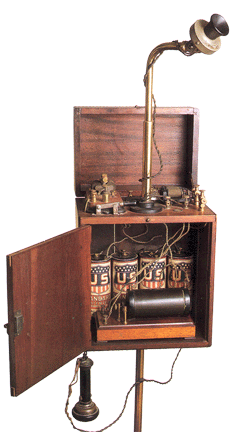
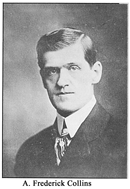
It had been two years
since Marconi’s successful wireless telegraph transmission
across the Atlantic ocean, and another year would pass before
the invention of the vacuum tube. Wireless Telegraphy, though
still in it’s infancy, held great promise for the future. Men
with names like DeForest, Edison, Fessenden, Marconi, and
Tesla were working intensely to make wireless a commercially
viable alternative to the wired telegraph.
At the same time, a much
smaller group was attempting to take wireless to the next
logical step – a wireless telephone. In May, 1903, one
of these men, A. Frederick Collins, formed the Collins Marine
Wireless Telephone Co, and soon after changed the name of the
company to Collins Wireless Telephone Co. As he prepared to
take the company public, this technical visionary formed
partnerships with businessmen of questionable character - men
more interested in making a killing in wireless stock
speculation than in building a successful company.
His first system
was known as the “Inductive System” and featured coils of
insulated wire four to five feet in diameter. The transmitting
coil carried current modulated by a microphone, which produced
a
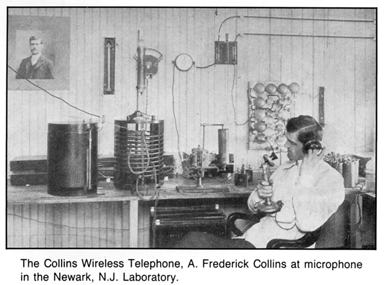 magnetic
field that varied with the speech of the speaker. The varying
magnetic field produced an electric current in the receiving
coil placed nearby, reproducing the speaker’s voice in a
telephone receiver. magnetic
field that varied with the speech of the speaker. The varying
magnetic field produced an electric current in the receiving
coil placed nearby, reproducing the speaker’s voice in a
telephone receiver.
Collins toured the United States. putting
on demonstrations and selling stock in the Collins Wireless
Telephone Co. The company made wild claims about his technology and
was vocal in predicting the downfall of telegraph stocks such
as Marconi. Usually two adjoining hotel rooms were rented
for the demonstration, placing the coils on opposite sides of
a wall. Celebrities and government officials
would be invited to demonstrate the apparatus. These demonstrations were
spectacular and resulted in appreciable stock sales.
Unfortunately the money received was used by the company to cover the expenses of marketing
its stock and to
promote further speculation, not for building the assets of
the company for the benefit of the stockholders.
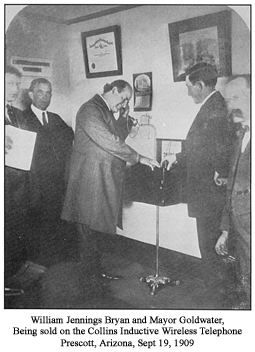 From
1900 to 1909 Collins wrote an incredible number of
technical articles
for science and trade journals, as well as best selling
wireless books including "Wireless Telegraphy" (1905), "Manual
of Wireless Telephony and Telegraphy" (1909), and "Design and
Construction of Induction Coils" (1909.) From
1900 to 1909 Collins wrote an incredible number of
technical articles
for science and trade journals, as well as best selling
wireless books including "Wireless Telegraphy" (1905), "Manual
of Wireless Telephony and Telegraphy" (1909), and "Design and
Construction of Induction Coils" (1909.)
In 1908 Collins
issued a two part catalogue which described induction
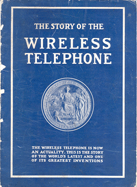 and
conduction equipment in the first part, a true wireless set in
the second part. He used an arc to generate the carrier and
modulated it by a carbon microphone. He claimed this unit
could span a distance of eighty miles with a power of 2.4 KW. and
conduction equipment in the first part, a true wireless set in
the second part. He used an arc to generate the carrier and
modulated it by a carbon microphone. He claimed this unit
could span a distance of eighty miles with a power of 2.4 KW.
The company had
a small shop in Newark. N.J. where demonstration equipment was
built but little apparatus was ever sold. In December, 1909
Collins Wireless Telephone Company became a part of the
Continental Wireless Tel. & Tel. Company, with A. Frederick
Collins as Technical Director. The stock prospectus promised A
Collins wireless telephone was to be installed in each
Continental station. None were installed.
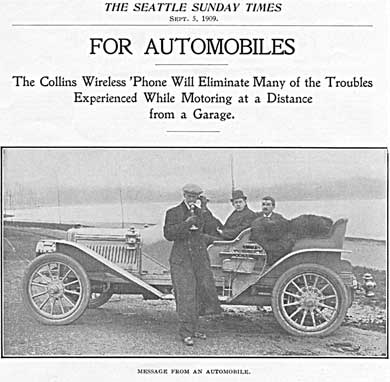
Stock Fraud
In December, 1911 four officers
of the Continental Wireless Co. were indicted for using the mails to
defraud in selling worthless stock.
According to the trial records,
they were charged with 5 counts in:
1. Selling worthless stock in
the Collins Wireless Telephone Co.
2. Persuading owners of Collins stock to buy worthless
Continental stock.
3. Selling worthless bonds of the Continental Co.
4. Selling worthless Continental stock.
In addition, A.
Frederick Collins was charged with giving a fraudulent
demonstration of his wireless telephone on Oct. 14, 1909 at
the Electrical Show in Madison Square Garden, New York, for
the purpose of selling stock in the Collins Wireless Telephone
Co.
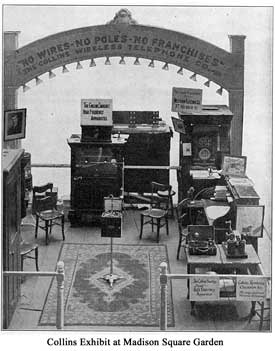
It was
developed at the trial that the four Collins officers had
claimed in their prospectus that the Collins wireless
telephone had been perfected to such an extent that in a
community equipped with it, any two subscribers could talk to
each other with total exclusion of all other subscribers, that
the Collins wireless telephone would do away with all central
exchanges. the necessity for wire lines, etc, that an
automobile so equipped would be in constant touch with a
garage so as not to be stranded in case of trouble, that
because of the lower cost of the wireless telephone, with no
wires needed, the telephone and telegraph systems would soon
be put out of business and that the demand for the equipment
would increase so rapidly that the stock price would quickly
increase. Click here
to see an example of these claims.
Four officers
were convicted on all five counts. Three were fined and
sentenced on January 10. 1913. to prison terms of up to four
years. This was the end of the Continental Wireless Tel. &
Tel. Co.
A. Frederick
Collins was sentenced to three years in jail in Atlanta. After
serving one year he was released.. Before his
conviction he had been a respected engineer, considered an
authority on wireless in general and a specialist in wireless
telephony. In his later career he wrote an amazing number of books on
a variety of subjects such as electricity, wireless, astronomy
and many other topics. He is most well known for “The Radio
Amateur’s Handbook," still in print and in it's 82nd edition!
The collapse of
Continental was mirrored by the downfall of other companies
such as United Wireless and DeForest. The era of bogus stock
selling had come to an end.
Bibliography
"Wireless Communication in the United States",
The New England Wireless and Steam Museum, 1989
"The Story of the Wireless
Telephone", Collins Wireless Telephone Company, 1909
"Modern Electrics", Vol 1, No. 5. "Collins
Wireless Telephone", Modern Electrics Publications
"Modern Electrics", Vol 1, No. 7. "Collins
Long Distance Wireless Telephone", Modern Electrics
Publications
|